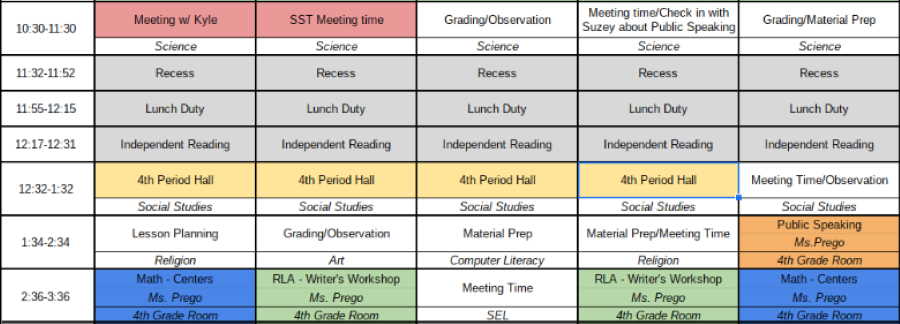Feel like you are always trying to find some "extra time" in the day...and realizing that it ends up being your evenings and weekends? Veteran teacher and TeacherVision Advisory Board member Mikaela has some suggestions for you.

Editor's Note: This post was originally written prior to the start of the COVID-19 outbreak, when "organizing your classroom" was a thing. Many of the strategies listed below will also be helpful for those teaching at home, and will most certainly be relevant once in-person classes resume.
Teaching can be a messy, uneven, chaotic business even on the best days, and even when performed by the most high-capacity, motivated, and organized people (like you). Cutting through that chaos to maintain a balance of efficiency and productivity in your work life and some harmony in your personal life IS an achievable goal - with a plan.
Here are some quick tips to help you save more time at school to give you more time to focus on you.
Planning Ahead
Many of us already know this; planning a week or two out helps to save time during the week. Still, I often find that while I may have planned, I am still printing, copying, or organizing materials on the day (or hour) I need them. First, set a day or deadline for your weekly lesson planning. I like to do it on Wednesdays because I have a long break period during the day and it gives me a sense of what material and concepts we’ve covered and where we will be able to go next. Second, don’t settle just for having your plans prepared! Set aside another time to organize your materials. A co-worker of mine prepared weekly packets and assignments and placed them in bins labeled for the day of the week they would be used.
Prioritize Your Break Time and Make a Schedule

Breaks can be difficult. There are a million things you could be doing, but without a plan it can feel like you did a little of everything and didn’t really get anything done. Making a clear schedule for your breaks gives you a routine so that you are better able to jump right into your work. At the beginning of the year, I make a copy of my class schedule and include the tasks I want to focus on during each of my planning periods. You can take a look at mine as an example. There are some days when it is hard to stick to my schedule, but the more I stick to it, the more I find that I have more time to get ahead on other work.
Personalized Stamps for Grading
Using stamps for grading is an idea I stole from a co-worker during my first years of teaching. If you’re ready to invest, there are lots of sites where you can customize your own stamps that will decrease the time you need for writing comments. If you’re on a budget, check out what’s at the craft store! I found a thumbs up stamp that I can use to show a thumbs up, a sideways thumb and a thumbs down. This connects to rubrics I use with my students in class, so they know what each thing means and there are next steps associated with them. Of course, there is some work where you do need to make personalized comments, but you can decide that before and for everything else you’ve got your stamps.
Templates
Templates save so much time for both communication and creating classroom materials. To send information home to families, I use templates designed for notes home, our weekly newsletter, missing homework and emails. It helps keep my communication concise. In the classroom I use templates for things like student writing drafts and brainstorming, as well as for giving students feedback. This helps students know what to expect and prevents me from making something new for every new lesson or topic. Making your templates can help personalize them, but there are also hundreds of templates that already exist. Don’t be afraid to use or buy something you like that someone has already created!
Do Nows & Extensions for Students
Along with your lesson planning, find quick work you can have your students do to begin the lesson. This will help them transition into work and give you a little time for last minute prep or to organize the materials. For math, my students start with fact fluency practice. Since the routine is the same almost every lesson, students know exactly what to do and can feel successful right away. As for students who finish early, some curricula have extension problems and work built in, however many do not. Having a folder of extension work ready in the classroom helps save time figuring out what early finishers can do on the fly. It also helps you focus on the students who need you!
Organize your Desk and Classroom
As I write this, I’m actually decluttering my desk of a million papers I no longer need and reorganizing so I know exactly where everything is and where it belongs. My personal preference for organization is bins. I like having a bin for grading, for exit tickets, for homework and materials for the week. It helps me keep everything in its place. You have your own preferences. Take some time to organize your desk so it’s a space that makes you feel productive and you don’t lose time searching through a messy pile of books, papers and whatever else ends up there.
Give Jobs to Students
As teachers, we take on a lot. Sometimes we take on more than we need to. A mentor told me, do not do for your students what they can do for themselves. For example, if you need papers handed out then a student can do that! Take a look at your daily routine. Where can students help you lighten your load? During my math classes, I have a student who goes around correcting and checking student work. I also have experts who can answer questions and support their classmates academically when I am working with a small group. I have students plugging in computers, watering plants and handling the calendar. Honestly, the more ownership we give our students, the more valued and responsible they feel, and that impacts their performance in the classroom.
Borrow Things
With the internet, we have access to so many things. When planning lessons and units, there’s no need to create everything yourself. There is nothing wrong with buying something from a site or using materials created by someone else. In addition to sites like TeacherVision, remember that you have experienced co-workers and colleagues too. Tap into the knowledge and resources that are available in your school. Don’t be afraid to borrow a good idea or ask someone what has worked for them. I am willing to bet that you have plenty of great ideas and resources to share as well.
Set Time Limits
I often think of teacher checklists as similar to a gas because no matter how much time we give them, they will continue to expand. Many of us are perfectionists and we can work forever. Setting a reasonable time limit for a task enables you to help make the work time productive, but also give you a point where you can set it down and move forward into other work or time for yourself.
What productivity tips do you use regularly? Share with us on Instagram, Facebook, Twitter, and Pinterest.
Mikaela Prego is an elementary educator from Massachusetts. She spent the last 3 years teaching 4th grade in Colorado, now she is back teaching in Massachusetts. Her favorite subjects to teach are math, science and social studies and she is a huge fan of putting the students in charge of as much of their learning as possible. You can follow her classroom (@whoareweintheworld) on Instagram.











